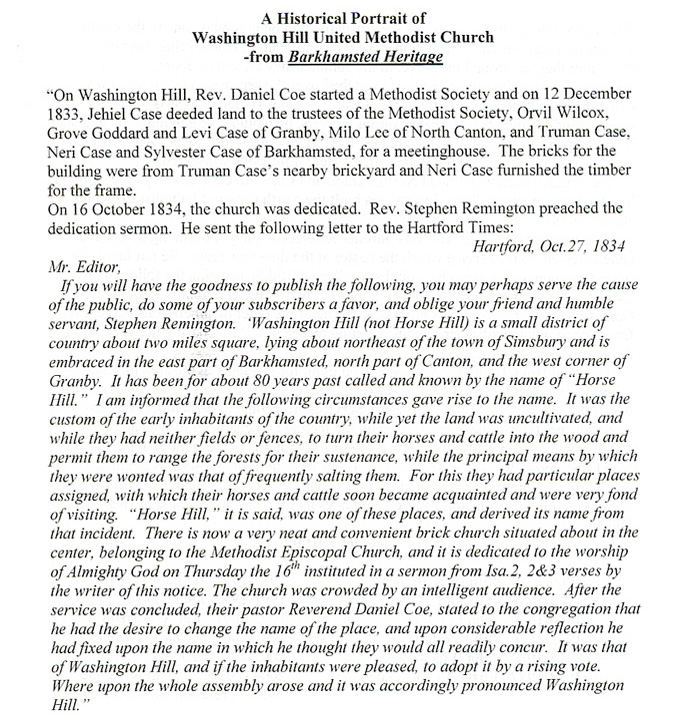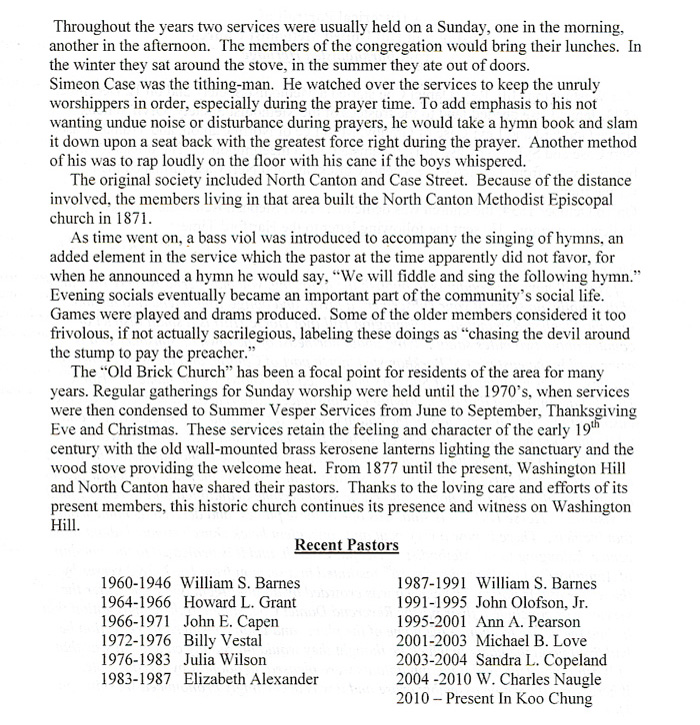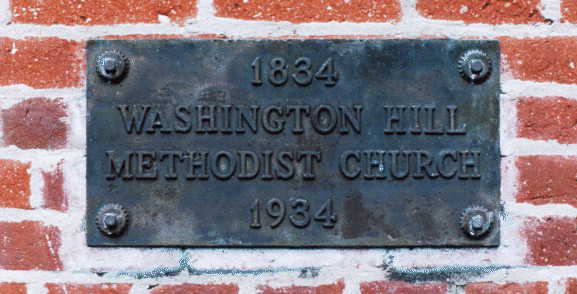The Old Brick Meeting House - History
Home Page |
The Old Brick Meeting House - Pictures


On the left hand side of the highway, Route 179, at the junction where the Canton and Barkhamsted town lines join, there used to stand a house that was very important to the early Methodists of Barkhamsted and North Canton. It was their first meeting place and it was here that they heard the first Methodist sermon and saw a man kneel in prayer.
In 1775, Philip Lilley conveyed these premises to Nathan Hatch of Hartland, which included "the house standing thereon." On March 14, 1777, Nathan Hatch conveyed the same to Peter Merritt, son of James Merritt, 1st.
Peter Merritt was one of the first in the State of Connecticut to support the Methodist Episcopal doctrine and opened his doors to the itinerant preachers. He was disciplined on the charge of heresy and as a result of this, the entire family joined with the Methodists. His son, Peter Merritt, 2nd , was the first Class Leader and the first Methodist Class in this area was formed at the home of Peter Merritt, 2nd . His home stood next to his father's house, to the south. Both houses have been gone for a great many years.
THE FIRST COMMUNION SET IN NORTH CANTON
The first Communion Service used in the North Canton Methodist Episcopal Church was given "In Memory of Peter Merritt." His brother, Timothy Merritt, became a Methodist preacher.
MOTHER CHURCH TO NORTH CANTON
The Methodist Episcopal Meeting House
On Washington Hill
Dedicated October 16, 1834

This beautiful old brick Meeting House has stood on Washington Hill for 165 years. It was (built 1833?), dedicated on October 16, 1834. It stands at the junction of Routes 179 and 219, in the town of Barkhamsted, Connecticut, and was the mother church of the North Canton Methodist Church, which celebrated its centennial in 1972.
This is an unusually beautiful building and is one of the very few prime examples of an early Methodist Meeting House remaining in Connecticut. Barkhamsted is extremely fortunate that it remains practically unchanged from the way it was first built and retains all its antique beauty. The usual Methodist Episcopal Meeting House of that period was constructed as economically as possible and lacked the fine architectural line and detail which we find present in this meeting house.
There are times when the lack of funds for building programs are a blessing in disguise and this is especially true as it relates here. Consequently, very few changes have been made in either the exterior or interior. There are the remains of an old chimney here at the Washington Hill Church, which started at the third floor line, in the "attic" area and went out through the roof. It may have been designed to meet the legal definition of "a house in which to hold meetings" thus avoiding the classification of "Church".
The Ecclesiastical tax was in effect as late as 1839-40. There was strong opposition to the Methodists, so they fought "fire with fire", taking whatever means were needed to avoid an out-and-out confrontation. There was a stove pipe connected to this chimney in later years. The stove was placed in the Sanctuary, directly below this chimney in the attic. A long stove pipe ran from the stove up to it, according to Newton LeGeyt. In this area, this type chimney was fairly common. I suppose it cost less to build. The chimney at the rear of the church was built recently enough, so that Newton LeGeyt remembers it being built.
I don't know when a stove was first put in this Meeting House. While stoves came into being as early as 1819, in city areas, the first stoves were quite an involved affair, also expensive, so did not gain popularity very rapidly in the country. When they did begin using them for heat, the stove was placed in the front, near the entrance doors. The stove pipe extended the full length of the church to near the pulpit area, connecting to the chimney on the outer wall in back of the pulpit. This was to gain the advantage of every bit of heat coming from the stove, as well as that coming from the stove pipe.
The old brick meeting house on Washington Hill still has this type of heating system. The lighting in the building is provided from several old brass lamps, which burn kerosene. Every Thanksgiving Eve, services are held in this building and draw a larger crowd each year. There is something very appropriate in thanking God for one's blessings, to be able to do so in this beautiful, old fashioned meeting house.
At the time of its construction, this spot was known as Horse Hill. The bricks for this building were burned and manufactured by Truman Case in his brick yard, which stood just below the site. Everyone in the neighborhood "favorable to the Methodists", took part in erecting this fine old meeting house, giving their service "in spells".
When the building was completed and dedicated on October 16, 1834, Rev. Stephen Remington was the preacher in charge and delivered the dedicatory sermon with its text from Isaiah 2:2-3: "And it shall some to pass in the last days that the mountains of the Lord's house shall be established in the top of the mountains, and shall be exalted above the hills; and all nations shall flow unto it
.."
The above is taken from A Scrapbook History of the North Canton Methodist Church compiled, published and copyrighted 1972 by Nettie Wright Adams, Editor, Lure of the Litchfield Hills, Collinsville, Connecticut 06022
Latest update: 10/18/2010
Top of the page




